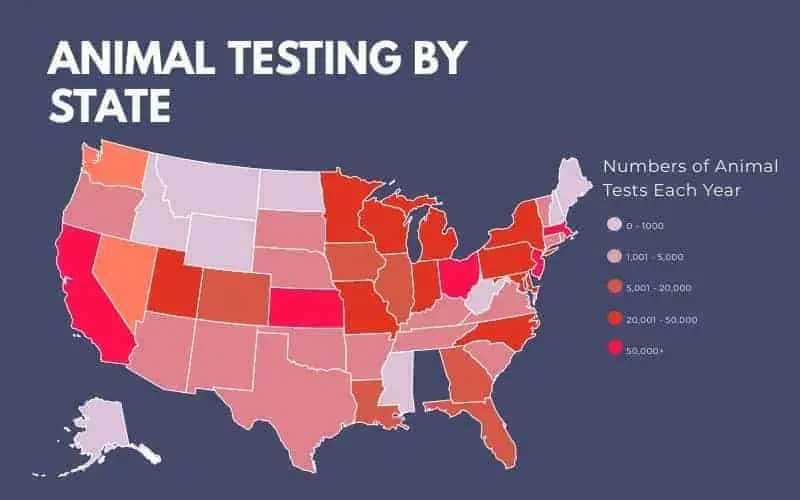- This post may contain affiliate links which - at no cost to you - may generate a small fee for us. It helps us research and review products more effectively
- Best estimates suggest the US performs well over 100 million animal tests each year
- And the USDA’s manipulative animal testing figures from 2019 show under 1 million animal tests
- Only 5 states have passed a ban on cosmetic animal testing (California, Illinois, Nevada, Virginia & Maryland)
Is Animal Testing Illegal in America?
There is no nationwide ban on cosmetic animal testing across the USA as of June 2021.
Whilst 5 states have banned it and there have been significant improvements in humane testing and the treatment of animals across other developed nations particularly, the USA lags well behind in its treatment of animals.
What States have Banned Animal Testing in America?
5 US states have completely banned animal testing on cosmetics: California, Illinois, Nevada, Virginia and Maryland.
California was the first to do so and that was as recently as 2018.
Animal Testing in the USA broken down by State

The US states that performed the most recorded tests on animals in 2019 are New Jersey (61,895), Ohio (62,300), California (62,338), Kansas (76,302) and Massachusetts (84,798).
California is the only one of these states that has banned cosmetic animal testing.
What are The USAs Animal Testing Laws?
- Currently the Animal Welfare Act (AWA) only protects mammals
- The USDA inspectors are in charge of inspecting over 100 animal testing facilities each year
- The PHS also rarely performs in-person checks
The Animal Welfare Act (AWA) – 1966
The Animal Welfare Act is still the only federal law in the USA the regulates the treatment of animals in research, exhibition, transport and dealers.
Whilst there are other acts that deal with specific details of animal welfare, all refer back to this as the standard bearer.
The AWA does require each institution using species covered under the bill to maintain an Institutional Animal Care and Use Committee, which is responsible for local compliance. These institutions must be audited and inspected at least annually.
The Health Research Extension Act of 1985
The Health Research Extension Act directed the National Institute of Health (NIH) to write the Public Health Service Policy (PHS) Policy on Humane Care and Use of Laboratory Animals.
Essentially any scientist or institution that gets federal funding for animal testing must have an IACUC. And a department within the PHS (The Office of Laboratory Welfare) enforces the recommendations for animal care made in the Guide for the Care and Use of Laboratory Animals: Eighth Edition.
The Farm Security Act – 2002
The Farm Security Act – the 5th amendment to the AWA – specifically excluded purpose-bred birds, rats, and mice (as opposed to those captured in the wild) from regulations.
And who are the USA’s Animal Testing Agencies?
The Public Health Service
The Public Health Service (PHS) isn’t a law as such, but an organisation that overseas the two agencies that facilitate the most testing on animals – The FDA (Food and Drug Administration) and The CDC (Centers for Disease Control and Prevention).
The PHS primary policy when it comes to animal welfare centres around dictating vertebrate animal care for federally funded labs. Unfortunately it rarely performs in-person checks and requires only written assurance.
The USDA (United States Department of Agriculture)
The USDA is the federal agency responsible for overseeing laboratories – and those who sell to labs – that experiment on animals.
According to its own data, the USDA employs 120 staff who are required to inspect more than 12,000 facilities – laboratories, zoos, research facilities, circuses et al.
So each inspector is in charge of over 100 facilities – hence its obvious inadequacies.
Animal Testing and Cosmetics in America
- Animal testing on cosmetics isn’t illegal in the USA (except in 5 states)
- The FDA is responsible for assuring that cosmetics are safe and properly labelled
- Companies can choose to perform animal testing to assure product safety and efficacy
Is Animal Testing on Cosmetics a Legal Requirement in the USA?
Animal testing on cosmetic products is not a legal requirement for products to be sold in the USA.
The Federal Food, Drug and Cosmetic Act, prohibits the sale of mislabelled and ‘adulterated’ cosmetics, but does not require that animal tests be conducted to demonstrate cosmetics safety and efficacy. It utilises animal testing alternatives in the majority of cases.
5 Terrifying Animal Testing Statistics in America
- 111,500,000 estimated procedures on animals in 2018
- 797,546 animals tested on according to USDA 2019 figures
- 7% animals that received no pain relief
- 19% primates, dogs and cats used – of documented figures
- $19.6 billion of taxpayer money was spent on animal testing in 2019
The USA records less than 1% of all animal tests in official statistics each year as the AWA doesn’t include the animals most commonly tested on – rats, mice and fish.
And of the $41.7 billion taxpayer funding the National Institute of Health (NIH), 47% is spent on animal testing specifically.
The Top 3 Reasons why America should ban Animal Testing
1. The USA Performs the Most Animal Tests each year
The USA performs the most animal tests each year around the world – significantly more in fact. Our best estimates believe it could be as many as 4-5 times more than China.
You can see the other worst offenders over on our animal testing statistics page.
2. Animal Testing is Highly Ineffective
Recent estimates claim that animal testing trials have a 96% failure rate.
That means that for every 100 drugs or ingredients that go through animal testing, only 4 actually make it through.
3. Animal Testing is Incredibly Expensive
For starters America spent almost $20 billion of taxpayer money on animal testing according to the most recent NIH figures.
At a 96% failure rate. Let that sink in.
Alternatives to animal testing are significantly more time and cost efficient. In the case of multi-year, multi-animal bioassay vs Syrian hamster embryo (SHE) cell transformation tests, the SHE test is 97% more cost effective.
Even simple tests like the draize rabbit eye test ($1800) is more expensive than it’s in vitro counterpart ($1400) – a whole 29% more expensive.
Animal Testing in the USA FAQs
Yes – cosmetic testing is only banned in 5 states across the USA – California, Nevada, Illinois, Virginia and Maryland.
No – whilst there isn’t a cosmetic testing ban in place nationwide, this is not a requirement.
In all likelihood, yes. There’s no testing ban on household products in America.
